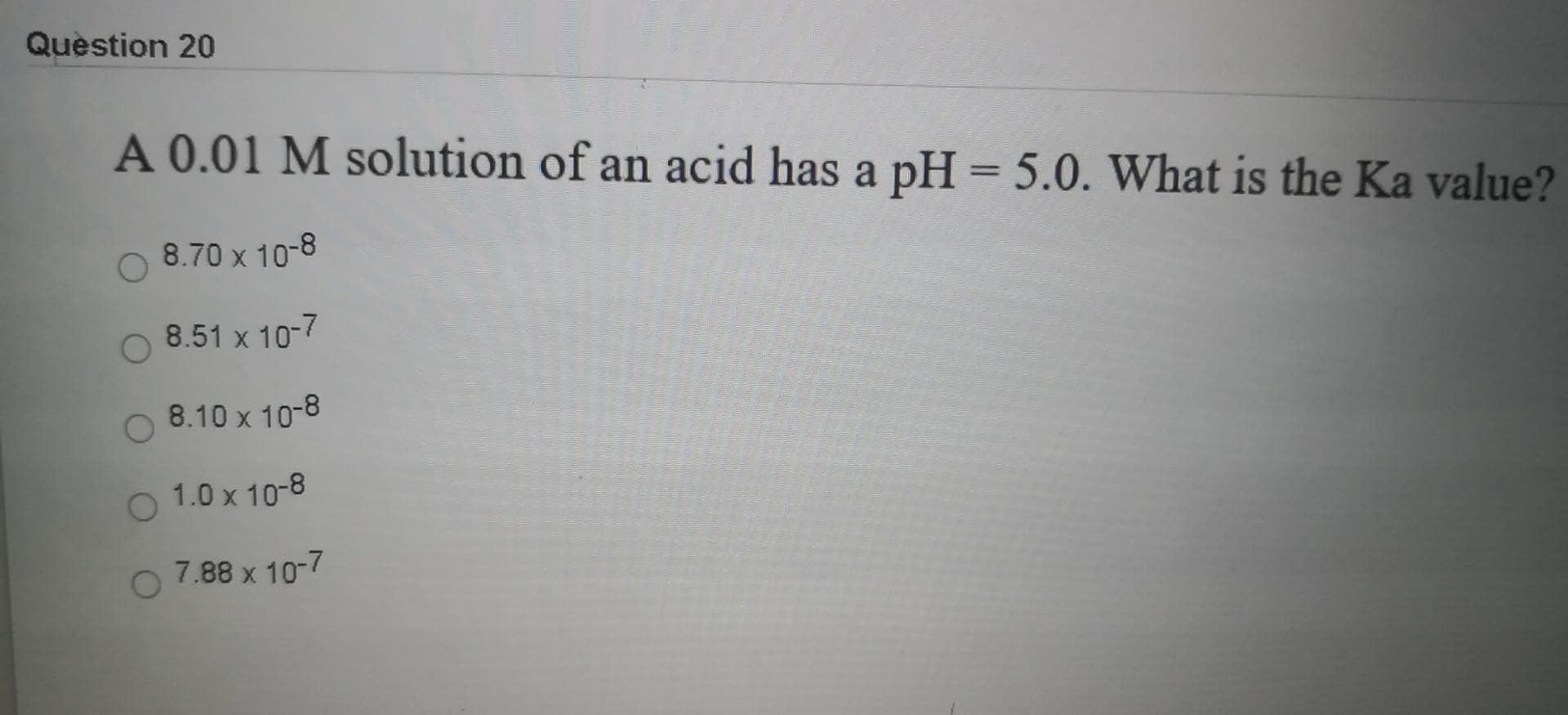The question is –
A 0.01 M solution of an acid has pH = 5.0. What is the Ka value?

Answer:
⇒ Ka = 1 x 10-8.
Explanation:
Acids are proton donors that get ionized to release H+ ions in water.
⇒ Considering pH 5.0, we assume that the acid given above is a monoprotic weak acid, i.e., it partially dissociates in an aqueous solution to produce a single H+ ion per HA molecule, as shown below.
HA (aq) ⇌ A– (aq) + H+ (aq) ………… Equation 1
⇒ An H+ ion combines with an H2O molecule to form a hydronium (H3O+) ion in an acidic solution.
HA (aq) + H2O (l) ⇌ A– (aq) + H3O+ (aq) ………… Equation 2 (Ionization Equilibrium)
⇒ The concentration of hydronium [H3O+] ions present in the solution determines its acidic strength. The higher the [H3O+], the lower the pH and the greater the strength of the acidic solution.
pH of the acidic solution = -log[H+]
or
pH = -log [H3O+] …………Equation 3
⇒ Rearranging equation 3 to make [H3O+] the subject of the formula.
[H3O+] = 10-pH ……. Equation 4
⇒ As the pH of the solution is given, i.e., pH = 5.0. So we can use equation 4 to determine the concentration of hydronium ions formed in the 0.01 M acidic solutions.
[H3O+] = 10-5.0 = 1 x 10-5 M.
⇒ As per equation 2, at equilibrium,1 mole of an acid (HA) dissociates to produce an equal concentration of A– (the conjugate base) and H3O+ (hydronium ions).
∴ So in our case, at equilibrium [H3O+] = [A–] = 1 x 10-5 M.
The initial HA concentration decreases to produce A– and H3O+ ions in the aqueous solution.
An equilibrium is achieved when there is no further change in concentrations at either the reactant and/or the product side.
⇒ The equilibrium constant for the dissociation of a weak acid in an aqueous solution is known as the acid dissociation constant, i.e., Ka.
K_{a}= \frac{[A^{-}][H_{3}O^{+}]}{HA} ………. Equation 5
In our example, [A–] = [H3O+] = 1 x 10-5 M (already determined).
⇒ The concentration of the weak acid at equilibrium [HA] = Initial acid concentration- concentration of H3O+ ions released in the aqueous solution.
[HA]equilibrium = [HA]initial – [H3O]+ ………. Equation 6
⇒ You may have noticed that [HA]initial is given in the question statement, i.e., 0.01 M.
[HA] equilibrium = (0.01) – (1 x 10-5) = 9.99 x 10-3 M
⇒ Plugging in all the required values in equation 5 successfully gives us the value of Ka for a 0.01 M acid solution.
K_{a}= \frac{(1\times 10^{-5})(1\times 10^{-5})}{(9.99\times 10^{-3})}
K_{a}= \frac{(1\times 10^{-10})}{(9.99\times 10^{-3})}
Ka = 1.00 x 10-8.
Answer: Ka = 1 x 10-8 (rounded off to one significant figure).
Note: As it is a ratio, so there are no units for Ka.

